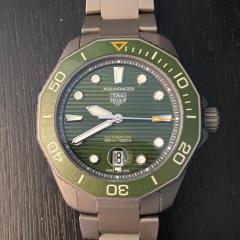-
Recently Browsing
- No registered users viewing this page.
-
Topics
-
Posts
-
By Neverenoughwatches · Posted
None of the pros here will agree that knocking a staff out is a good idea however it is carried out. After cutting one out i can now see why, in this case this morning the staff rivet was thick and sunk in deep on the balance wheel, i seemed to be cutting it forever, i had to stop twice to re-sharpen the graver and wondered when the wheel would become free, maybe why i caught the wheel, i was beginning to get impatient, it took a lot longer than i thought it would do. -
By LazyTimegrapher · Posted
I probably will open the watch eventually and when I do I’ll post pictures of the movement. It should be possible to figure out what grade it is once I’m able to take a look at it. Given the positional variation and the daily rates I’m seeing at full wind, it’s hard to believe it’s a top grade movement though. I’ve seen others talk about SW200-1 movements claiming very high accuracies that are often significantly better than COSC standards. -
By GrumpyOlMan · Posted
Expat in Argentina. Forced into "retirement" - too old, too foreign. Been watching a ton of videos and I have always loved LOVED pocket watches since I saw my first one. I might get into wrist watches - wife wants to see if I can fix her grandmother's watch, it'll be a while before I am comfortable with that. Found an inexpensive tool kit here, not the best of tools, but starter stuff. I am never shy about asking for help, a master in my trade - and have always learned from apprentices, zero ego. Thanks for having me. -
Personally, I would be wary of re-pinning the stud and make the hairspring longer to compensate for the watch running fast, because it is more than likely the balance that has had weight taken from it when the poise screws have been shaved and removed weight from the balance which naturally will increase the timing, thus the index being all the way to one side to slow the balance down, Re-pinning the hairspring is going to change the pinning up point (where the spring passes between the regulator pins), but may also change the vibration rate of the spring slightly, which isn't the correct way to slow things down, unless it was incorrect to begin with, but to know that for sure you'll need a hairspring vibrating tool. This method will increase the timing, but I doubt it will run exactly at 18000 BPH anymore because of re-pinning the spring where it shouldn't ideally be. Adding timing washers is the way forward to alleviate this problem and slow the timing down, I believe. Having plenty excess of hairspring after the stud isn't a problem as long as it doesn't touch anything.
-







Recommended Posts
Join the conversation
You can post now and register later. If you have an account, sign in now to post with your account.
Note: Your post will require moderator approval before it will be visible.